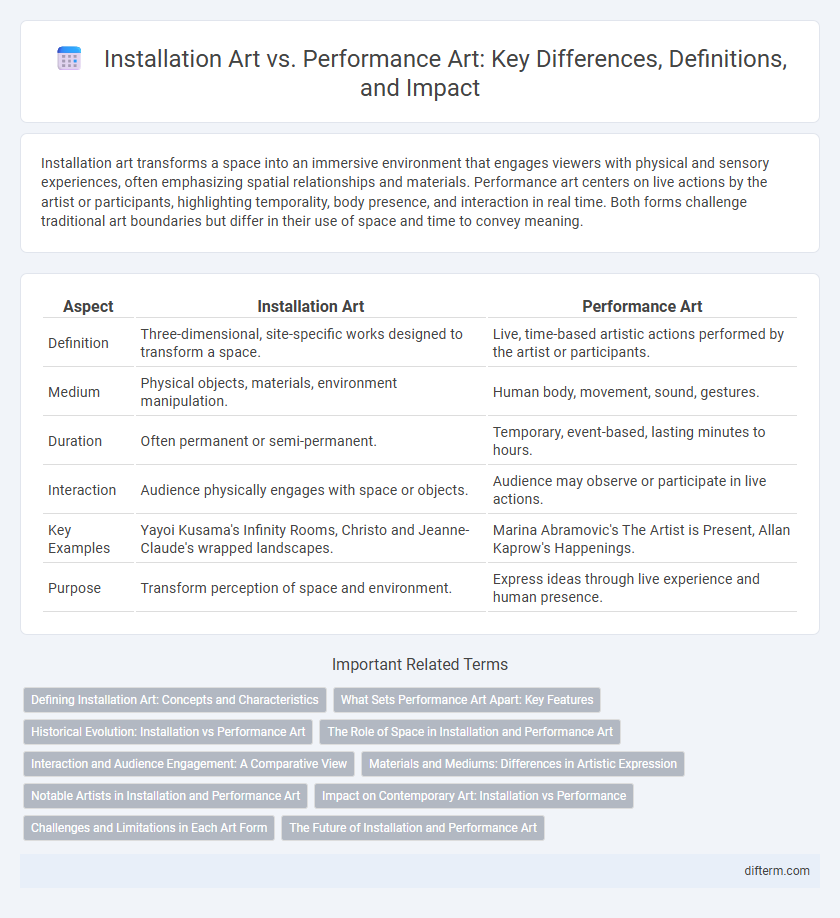Installation art transforms a space into an immersive environment that engages viewers with physical and sensory experiences, often emphasizing spatial relationships and materials. Performance art centers on live actions by the artist or participants, highlighting temporality, body presence, and interaction in real time. Both forms challenge traditional art boundaries but differ in their use of space and time to convey meaning.
Table of Comparison
| Aspect | Installation Art | Performance Art |
|---|---|---|
| Definition | Three-dimensional, site-specific works designed to transform a space. | Live, time-based artistic actions performed by the artist or participants. |
| Medium | Physical objects, materials, environment manipulation. | Human body, movement, sound, gestures. |
| Duration | Often permanent or semi-permanent. | Temporary, event-based, lasting minutes to hours. |
| Interaction | Audience physically engages with space or objects. | Audience may observe or participate in live actions. |
| Key Examples | Yayoi Kusama's Infinity Rooms, Christo and Jeanne-Claude's wrapped landscapes. | Marina Abramovic's The Artist is Present, Allan Kaprow's Happenings. |
| Purpose | Transform perception of space and environment. | Express ideas through live experience and human presence. |
Defining Installation Art: Concepts and Characteristics
Installation art transforms spaces by integrating various materials and sensory elements to create immersive environments that engage viewers physically and emotionally. Unlike traditional art forms, it often emphasizes spatial relationships, encourages interaction, and challenges perceptions of space and context. Key characteristics include site-specificity, temporal variability, and the fusion of visual, auditory, and tactile components to construct multi-dimensional experiences.
What Sets Performance Art Apart: Key Features
Performance art distinguishes itself through the integration of live action, time-based experiences, and direct audience engagement, creating an ephemeral and dynamic encounter that installation art lacks. Unlike static installations, performance art relies on the artist's physical presence, movement, and interaction as central components. This temporal and participatory nature emphasizes immediacy and transformation, setting performance art apart as a uniquely immersive form within contemporary artistic practices.
Historical Evolution: Installation vs Performance Art
Installation art emerged in the early 20th century, gaining prominence through movements like Dada and Surrealism, emphasizing spatial experience and viewer interaction within defined environments. Performance art developed as a distinct practice in the 1960s, rooted in Fluxus and conceptual art, prioritizing live actions and temporality over static objects. Both forms evolved as radical departures from traditional art, challenging conventional boundaries and expanding artistic expression through immersive and ephemeral experiences.
The Role of Space in Installation and Performance Art
Installation art transforms physical space into an immersive environment that engages viewers through spatial relationships, materiality, and sensory experiences. Performance art utilizes space as a dynamic stage where the artist's body interacts with the environment, emphasizing temporality and presence. Both art forms rely on spatial context to create meaning, but installation art alters the perception of space itself, while performance art activates space through live action.
Interaction and Audience Engagement: A Comparative View
Installation art creates immersive environments that engage the audience by transforming space and encouraging physical interaction, often inviting viewers to explore and reinterpret the artwork from multiple perspectives. Performance art involves live actions by the artist or participants, emphasizing real-time audience engagement through movement, sound, and presence, fostering an immediate emotional or intellectual connection. Both forms prioritize interaction but differ in temporality and sensory dynamics, with installation art offering sustained, spatial experiences and performance art providing ephemeral, participatory encounters.
Materials and Mediums: Differences in Artistic Expression
Installation art employs physical materials such as sculptures, found objects, and environments to create immersive spatial experiences that engage viewers visually and tactilely. Performance art utilizes the human body, time-based actions, and ephemeral gestures as its primary mediums, emphasizing live interaction and temporality. The contrast between solid materials in installation art and the transient nature of performance art highlights distinct approaches to artistic expression and audience engagement.
Notable Artists in Installation and Performance Art
Installation art features pioneers like Yayoi Kusama, whose immersive environments challenge spatial perception, and Olafur Eliasson, known for integrating natural elements and technology to engage viewers. Performance art highlights influential figures such as Marina Abramovic, celebrated for her endurance-based works exploring human limits, and Joseph Beuys, who combined social philosophy with artistic action in participatory performances. These artists represent pivotal contributions that define and expand the boundaries of their respective disciplines.
Impact on Contemporary Art: Installation vs Performance
Installation art transforms spaces into immersive experiences, challenging viewers' perceptions and encouraging multi-sensory engagement, which has expanded the boundaries of contemporary art. Performance art emphasizes the artist's live actions as a medium, blurring the lines between art and life, and has introduced immediacy and temporality to contemporary artistic expression. Both forms have significantly influenced contemporary art by redefining the relationship between artwork, audience, and environment.
Challenges and Limitations in Each Art Form
Installation art faces challenges in spatial constraints and material durability, often requiring extensive planning for site-specific engagement and long-term preservation. Performance art encounters limitations related to temporal ephemerality and audience interaction, making documentation and reproducibility critical but challenging for lasting impact. Both art forms demand adaptive strategies to overcome their inherent physical and experiential boundaries.
The Future of Installation and Performance Art
Installation art is evolving through the integration of augmented reality and interactive technologies, allowing audiences to engage with immersive, multisensory environments. Performance art increasingly incorporates digital media and virtual platforms, expanding its reach beyond physical spaces to global audiences in real-time. The future of these art forms lies in their hybridization, where boundary-blurring experiences merge spatial and temporal dimensions to create novel artistic expressions.
Installation Art vs Performance Art Infographic

 difterm.com
difterm.com